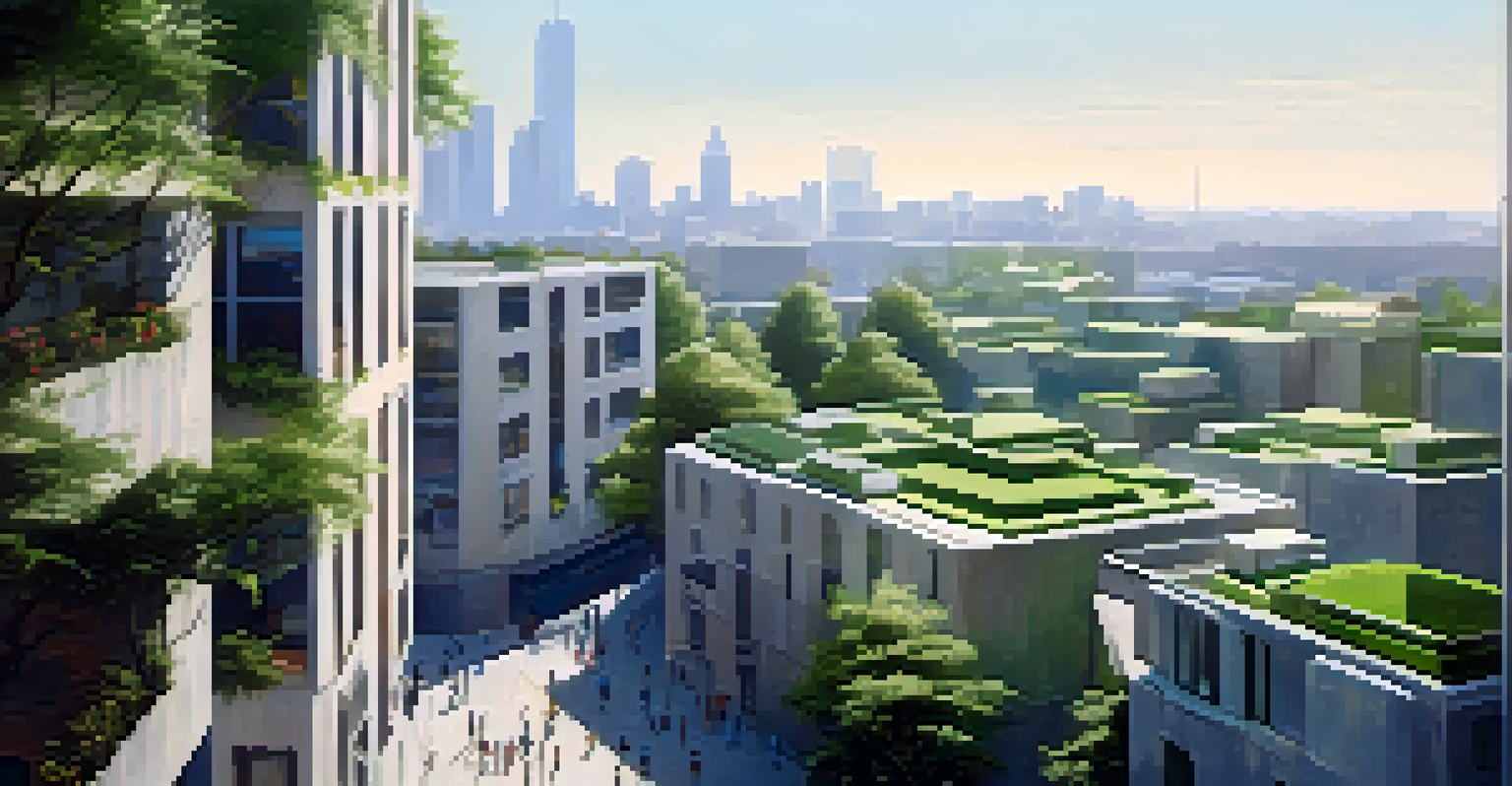Illinois' Urban Heat Islands: Causes and Mitigation Strategies

What Are Urban Heat Islands and Why Do They Matter?
Urban heat islands (UHIs) refer to urban areas that experience significantly higher temperatures than their rural surroundings. This phenomenon occurs due to human activities and the prevalence of heat-absorbing materials, such as asphalt and concrete. Understanding UHIs is crucial because they can lead to increased energy consumption, elevated emissions of air pollutants, and negative health impacts.
The best way to predict the future is to create it.
In Illinois, cities like Chicago and Aurora are prime examples of UHI effects, where the temperature can be several degrees warmer than nearby rural areas. These temperature disparities can exacerbate heatwaves, putting vulnerable populations at greater risk. Thus, recognizing the importance of UHIs is the first step in addressing their impacts.
Moreover, the consequences of UHIs extend beyond just discomfort; they can strain local resources, especially in terms of energy and water usage. The need for effective mitigation strategies becomes essential to create a more sustainable urban environment and enhance residents' quality of life.
Key Causes of Urban Heat Islands in Illinois
The primary contributors to urban heat islands in Illinois are land use changes and the urban heat generated from human activities. As cities expand, natural landscapes are replaced with buildings and roads, which absorb and retain heat. This shift not only raises temperatures but also limits the cooling effects of vegetation.

Additionally, industrial activities and increased vehicle emissions contribute significantly to the heat generated in urban areas. The more cars we have on the road and factories we operate, the more heat is released into the atmosphere, exacerbating the UHI effect. This is particularly noticeable in densely populated regions of Illinois, where traffic congestion is commonplace.
Urban Heat Islands Raise Temperatures
Urban heat islands (UHIs) cause cities like Chicago to experience significantly higher temperatures than surrounding rural areas, impacting energy consumption and public health.
Lastly, the lack of adequate green spaces in urban areas further intensifies the heat island effect. Without parks and trees to provide shade and cool the air, cities become heat traps. This highlights the importance of integrating nature into urban planning to mitigate these effects effectively.
Impact of Urban Heat Islands on Health and Environment
The health implications of urban heat islands are significant, particularly for vulnerable populations such as the elderly and those with pre-existing health conditions. Higher temperatures can lead to heat-related illnesses, prompting increased hospital visits during summer months. In Illinois, the combination of heat and humidity can create dangerous conditions, raising the urgency for effective solutions.
Nature does not hurry, yet everything is accomplished.
Moreover, UHIs can exacerbate air pollution, as warmer temperatures can increase the formation of ground-level ozone. This poses a serious health risk, contributing to respiratory issues and other related illnesses. Residents in urban areas like Chicago may find themselves facing more smog days, impacting their overall quality of life.
Environmental impacts are also noteworthy, as increased heat can influence local ecosystems. Higher temperatures can disrupt plant and animal life cycles, leading to biodiversity loss. Understanding these impacts is crucial for developing comprehensive mitigation strategies that prioritize both public health and environmental sustainability.
Mitigation Strategy: Increasing Urban Green Spaces
One of the most effective ways to combat urban heat islands is by increasing urban green spaces. Planting trees, creating parks, and developing green roofs can significantly lower surface and air temperatures. For instance, cities across Illinois have started initiatives to plant more trees along streets and in public parks, helping to provide shade and improve air quality.
Green spaces not only cool the environment but also enhance the overall aesthetic and recreational quality of urban areas. They serve as vital community hubs, encouraging outdoor activities and social interactions. This approach not only addresses UHI issues but also promotes mental well-being and community engagement.
Green Spaces Mitigate Heat Effects
Increasing urban green spaces, such as parks and trees, is an effective strategy to lower temperatures and improve air quality in cities.
Furthermore, incorporating nature into urban planning can also improve stormwater management. Green spaces can absorb rainwater and reduce runoff, mitigating flooding risks exacerbated by urbanization. This interconnectedness of benefits makes increasing green spaces a cornerstone of effective UHI mitigation strategies.
Cool Roofs and Pavements: Innovative Solutions
Another promising mitigation strategy involves the use of cool roofs and pavements. Cool roofs are designed to reflect more sunlight and absorb less heat than standard roofs, which can significantly reduce indoor temperatures. In Illinois, building owners are increasingly adopting reflective materials to combat heat, leading to reduced energy costs and improved comfort.
Similarly, cool pavements, which are lighter in color and designed to reflect sunlight, can help lower surface temperatures on streets and sidewalks. These materials can effectively decrease the ambient temperature in urban areas, providing immediate relief from heat. Cities like Chicago have begun testing these materials in public spaces, showcasing their potential benefits.
Implementing these technologies not only addresses UHI effects but also contributes to sustainability goals. By reducing energy consumption and enhancing thermal comfort, these solutions align with broader efforts to combat climate change and promote eco-friendly urban development.
Community Engagement in Mitigation Efforts
Community engagement plays a critical role in successfully addressing urban heat islands. Local organizations and residents can collaborate to identify UHI hotspots and develop tailored solutions that fit their unique environments. By fostering a sense of ownership and involvement, communities are more likely to support and sustain these initiatives.
Educational programs can also help raise awareness about the effects of urban heat islands and the importance of green spaces. Workshops, community meetings, and social media campaigns can inform residents about how they can contribute to mitigation efforts, such as tree planting or participating in local sustainability programs.
Community Involvement is Essential
Engaging local communities in UHI mitigation efforts fosters ownership and leads to more sustainable, tailored solutions for urban environments.
Moreover, engaging with local governments can amplify these efforts. Collaborating with policymakers ensures that community voices are heard in urban planning processes, leading to more effective and inclusive solutions. Together, communities can drive meaningful change and create healthier, more livable urban environments.
The Future of Urban Heat Islands in Illinois
Looking ahead, the challenge of urban heat islands is only expected to grow with climate change. As temperatures continue to rise, Illinois cities will need to adapt proactively. This means prioritizing both immediate and long-term strategies for UHI mitigation to protect residents and the environment.
Innovative technologies and collaborative community efforts will play a crucial role in shaping the future of urban landscapes. By integrating sustainable practices into urban planning, cities can create resilient environments that thrive despite rising temperatures. This adaptability will be key to ensuring the health and well-being of future generations.

Ultimately, addressing urban heat islands requires a multifaceted approach that combines policy changes, community engagement, and innovative solutions. By working together, Illinois can pave the way for cooler, greener, and more sustainable urban spaces for everyone.